How to Interpret the Meaning of the Claddagh Symbol
The Claddagh symbol, originating in 17th century Claddagh, Galway, Ireland, represents profound values of love, friendship, and loyalty. Crafted by local goldsmiths, it is attributed to fisherman-turned-goldsmith Richard Joyce.
The heart at the center of the symbol denotes love, while the crown stands for loyalty and the hands signify friendship and unity. This emblem of Irish cultural identity proudly showcases exceptional Irish artisan craftsmanship and has become a marker of enduring heritage.
Its significance extends beyond borders, symbolizing enduring romance, familial love, and faithfulness. To truly appreciate its cultural depth and modern relevance, further exploration is merited.
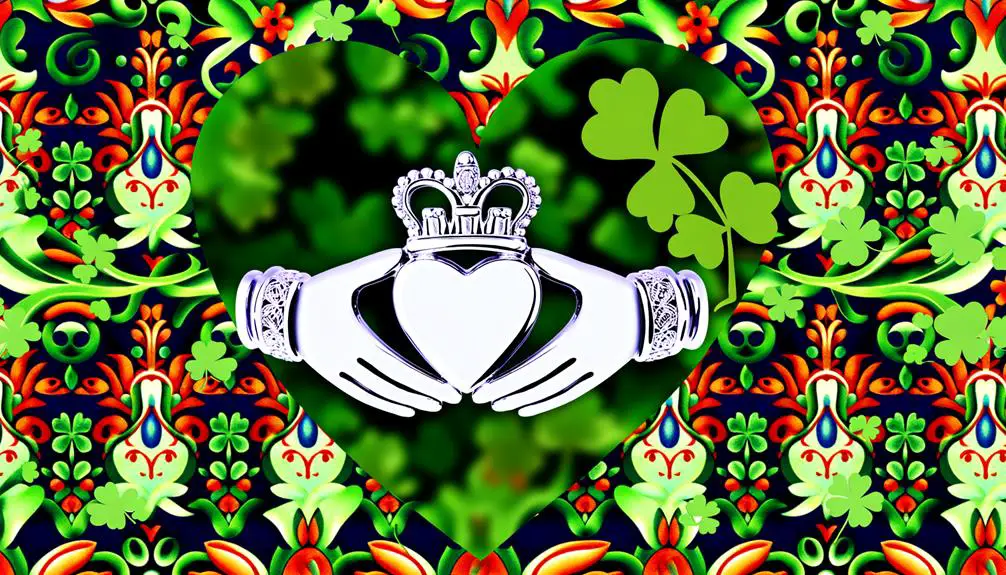
Key Takeaways
- The heart in the Claddagh symbolizes love and affection.
- The crown represents loyalty and regal authority in relationships.
- The hands signify unity, friendship, and mutual support.
- The Claddagh symbol originated in 17th century Claddagh, Galway, Ireland.
- It embodies enduring themes of love, friendship, and loyalty across various relationships.
Origins of the Claddagh
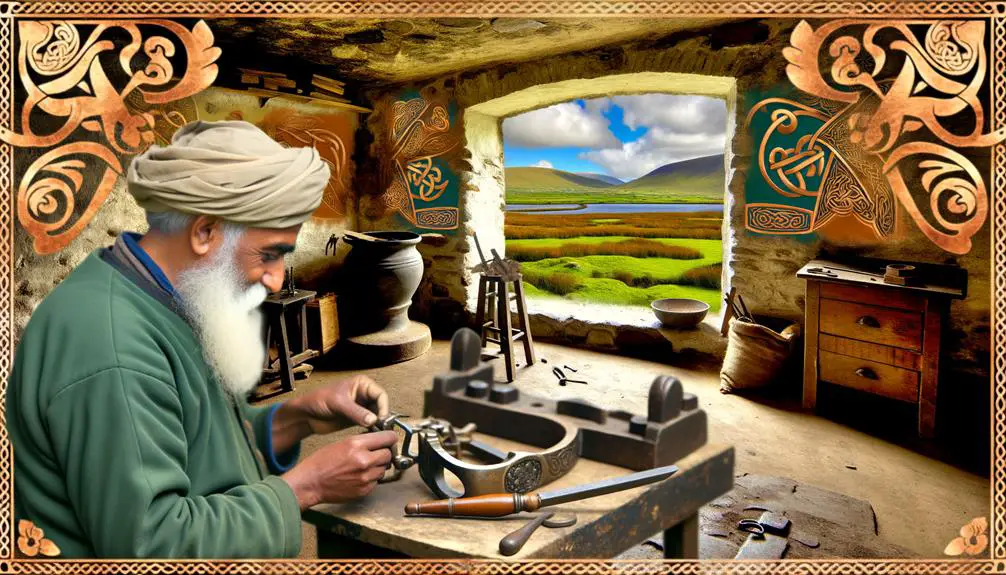
The origins of the Claddagh symbol trace back to the 17th century in a small fishing village named Claddagh, located just outside the old city walls of Galway, Ireland. This emblem, marked by two hands clasping a crowned heart, emerged from an area deeply rooted in maritime traditions and communal ties.
Crafted by local goldsmiths, the Claddagh ring symbolizes love (the heart), friendship (the hands), and loyalty (the crown). Its creation is attributed to Richard Joyce, a fisherman who, according to legend, was captured by pirates and learned the craft while enslaved. Upon his release, Joyce brought this unique design back to his homeland, embedding it within the cultural fabric of Galway and beyond, transcending its origins to become a universal icon.
Historical Significance
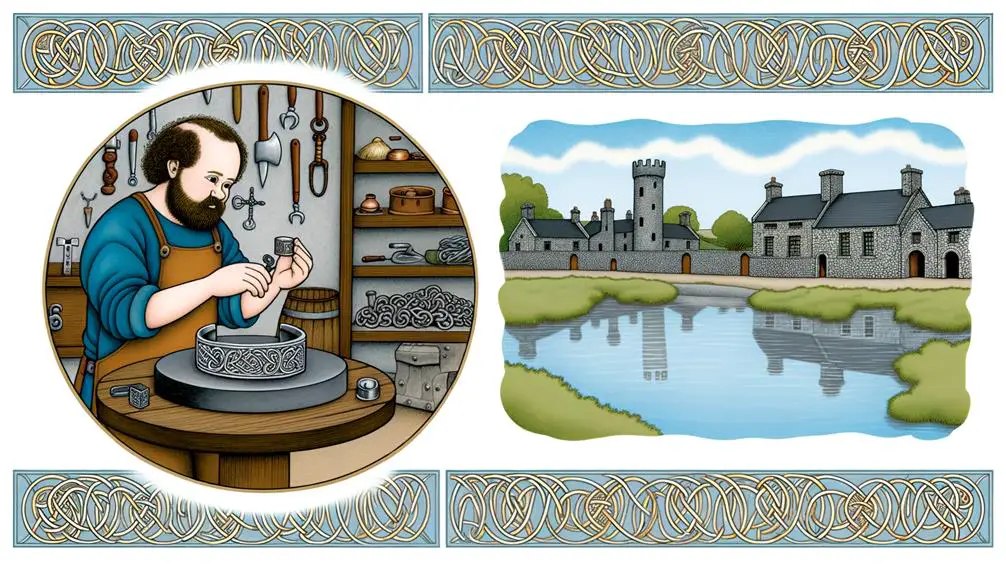
In examining the historical significance of the Claddagh symbol, it becomes evident that its enduring legacy is deeply intertwined with the cultural and social dynamics of Ireland. Originating in the small fishing village of Claddagh in Galway, this symbol has transcended geographical boundaries and historical epochs to become a poignant emblem of Irish heritage.
Its historical importance can be broken down into several key aspects:
- Cultural Identity: The Claddagh symbol serves as a marker of Irish identity, representing the nation's rich folklore and traditions.
- Social Bonds: Historically, the Claddagh ring has been used to signify relationships, particularly in matrimonial contexts.
- Artisan Craftsmanship: The intricate design of the Claddagh ring highlights the exceptional skills of Irish jewelers, preserving traditional craftsmanship.
Symbolism of the Heart
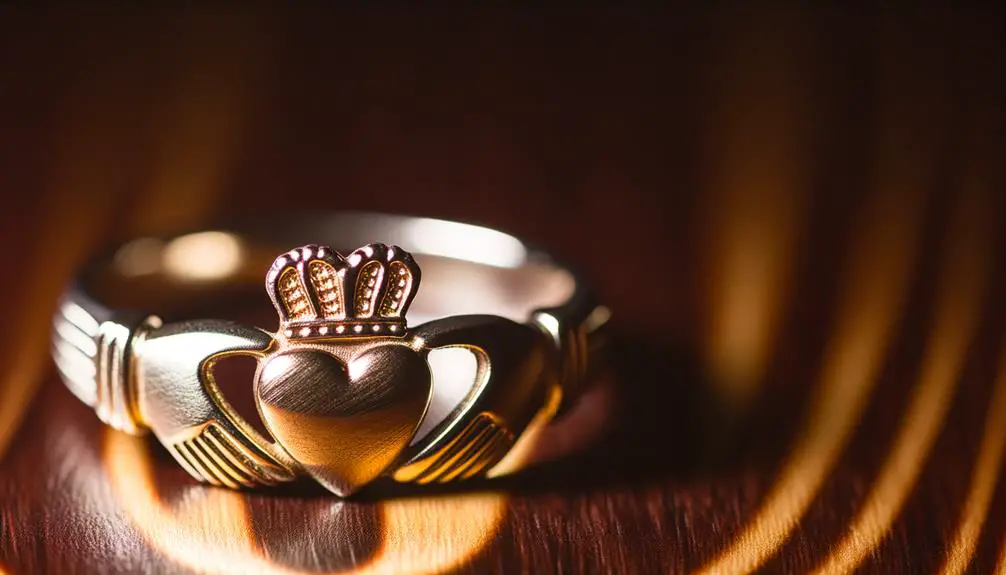
The heart in the Claddagh symbol is a profound representation of love and affection, making it a poignant element in Irish cultural heritage.
Historically, the heart has been emblematic of emotional connection, signifying deep bonds between individuals.
This symbolism resonates through centuries, echoing the enduring human desire for relational intimacy and fidelity.
Love and Affection
Rooted in deep cultural and historical significance, the heart in the Claddagh symbol eloquently represents love and affection, embodying the core of human emotional connection. Originating from 17th-century Irish tradition, the Claddagh's heart has transcended time, symbolizing unwavering romantic love and deep familial bonds.
Its design encapsulates:
- Enduring Romance: The heart signifies a love that withstands the trials of time, reflecting loyalty and commitment.
- Familial Love: Beyond romantic connotations, it represents the affection and unity within families, strengthening kinship ties.
- Cross-Cultural Resonance: While Irish in origin, the Claddagh's heart has universal appeal, resonating with diverse cultures as a timeless emblem of love.
This powerful symbol endures, reflecting humanity's intrinsic need for connection and affection.
Emotional Connection
Although often associated with romantic affection, the heart in the Claddagh symbol intricately embodies a broader spectrum of emotional connections, serving as a profound representation of empathy, compassion, and human solidarity throughout history.
Originating in 17th-century Ireland, this symbol transcends its initial connotations of romantic love to encapsulate universal human emotions. The heart, at its core, signifies an unspoken bond that connects individuals in familial, platonic, and communal relationships.
This versatility is deeply rooted in Celtic traditions, which emphasize interconnectedness and mutual support. The Claddagh heart consequently stands as a timeless emblem, uniting people across different cultures and eras through shared experiences of kindness and emotional understanding, reinforcing the communal fabric of society.
Meaning of the Crown
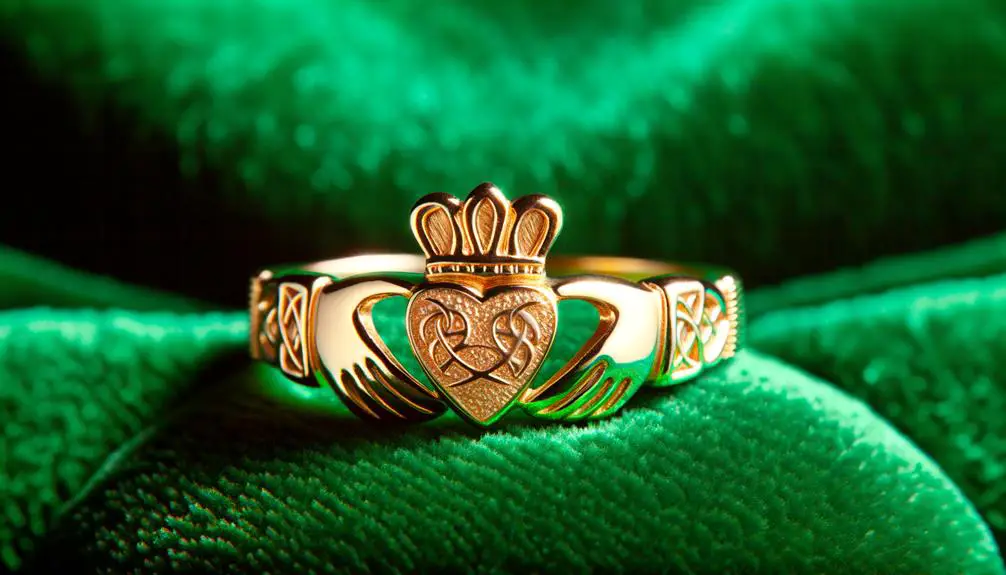
The crown atop the Claddagh symbol holds profound significance, embodying not only the concept of loyalty but also a sense of regal authority.
Historically, crowns have been synonymous with leadership and commitment, reflecting a deep-rooted cultural reverence for steadfastness.
This dual symbolism underscores the Claddagh's message of enduring loyalty and noble fidelity in relationships.
Symbol of Loyalty
In the Claddagh symbol, the crown represents loyalty, underscoring the historical and cultural significance of steadfastness and fidelity in Irish tradition. This emblem of loyalty is deeply rooted in the values that shape Irish societal bonds and relationships. The crown's symbolism can be analyzed through several key aspects:
- Historical Context: Loyalty has been a cornerstone of Irish clans and families, often determining alliances and social cohesion.
- Cultural Significance: In Irish folklore, loyalty is an esteemed virtue, celebrated in stories, music, and communal rituals.
- Symbolic Representation: The crown atop the Claddagh ring serves as a visual reminder of unwavering faithfulness, an essential element in friendships, marriages, and communal ties.
Understanding these facets enriches the appreciation of the Claddagh symbol.
Regal Significance
Rooted in the rich history of Irish monarchy, the crown in the Claddagh symbol epitomizes regal authority and sovereignty, reflecting the enduring legacy of Irish kings and queens. This emblematic crown is not merely ornamental; it carries profound historical and cultural significance.
Historically, the crown has signified leadership, governance, and the divine right of rulers. In the context of the Claddagh, it transcends its traditional royal connotations to symbolize loyalty and fidelity. The crown's presence underscores a commitment to uphold honor and integrity, reminiscent of the virtues expected of nobility.
Consequently, the crown in the Claddagh ring is a poignant reminder of the intertwined nature of leadership, loyalty, and the timeless values of the Irish heritage.
The Role of the Hands
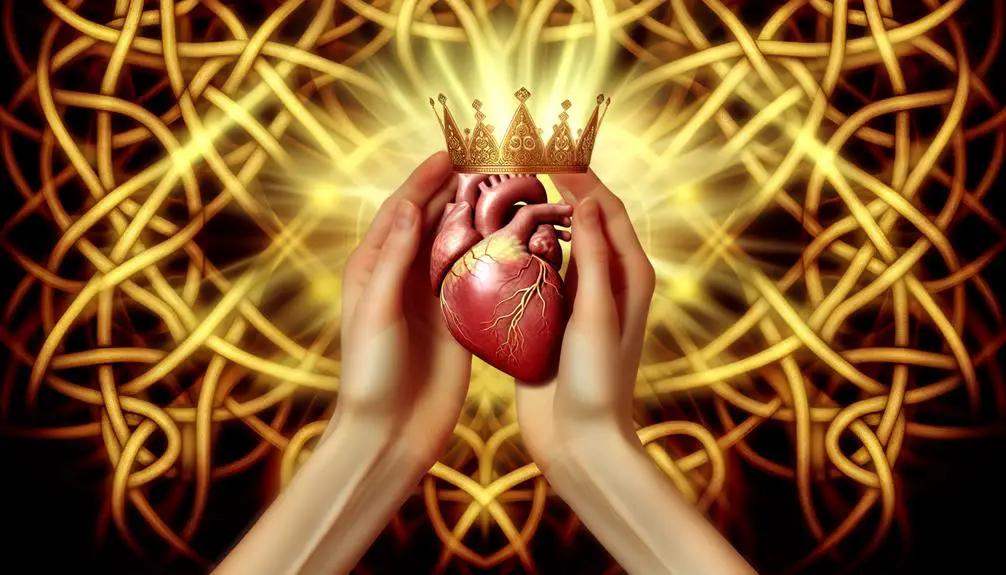
Symbolizing unity and friendship, the hands in the Claddagh symbol represent the bond of trust and affection between individuals, drawing from centuries-old traditions in Irish culture. This intricate design element has profound meanings:
- Historical Context: The hands date back to the original Claddagh ring created in the 17th century in the village of Claddagh. They signify the enduring nature of human connection.
- Detailed Analysis: The hands clasping each other illustrate mutual support and loyalty, essential values in both romantic and platonic relationships.
- Cultural Significance: In Irish heritage, the hands are a tribute to collective unity, often exchanged as symbols of lifelong friendship and familial bonds.
These elements highlight the timeless essence of the Claddagh symbol.
Cultural Impact
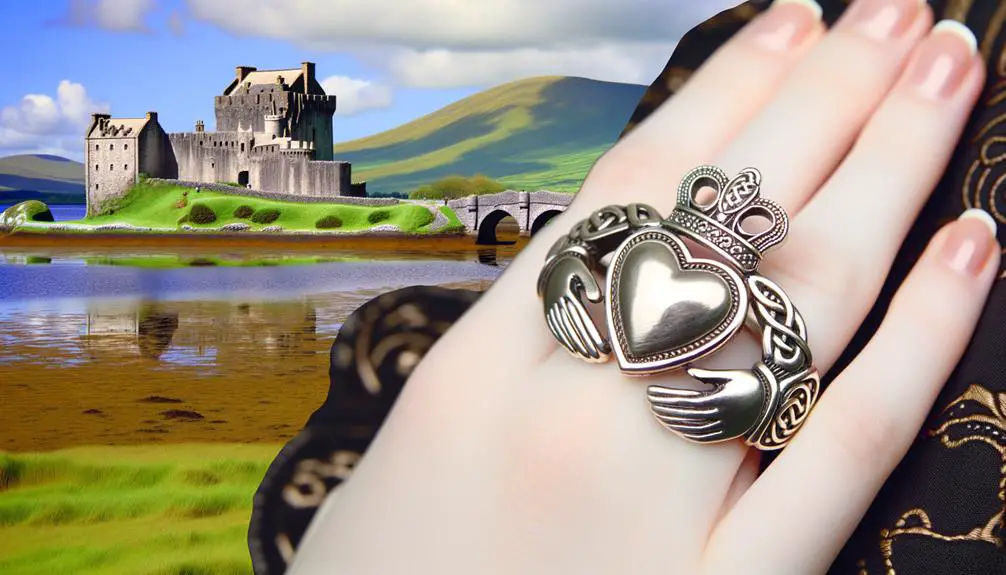
The Claddagh symbol, with its hands embodying unity and friendship, has permeated various cultures and traditions beyond its Irish origins, demonstrating its widespread cultural impact and significance. Historically, the Claddagh's design has been embraced by diverse communities, symbolizing universal themes of love and loyalty. Its adoption in different regions highlights its versatility and deep-rooted cultural resonance.
| Region | Cultural Adoption |
|---|---|
| Ireland | Traditional wedding and friendship rings |
| United States | Symbol of Irish heritage and community |
| Mexico | Incorporated into folkloric art and jewelry designs |
| Japan | Featured in fashion as a symbol of global unity |
This cultural diffusion underscores the Claddagh's enduring appeal, reflecting shared human values and fostering a sense of interconnectedness across borders.
Modern Interpretations
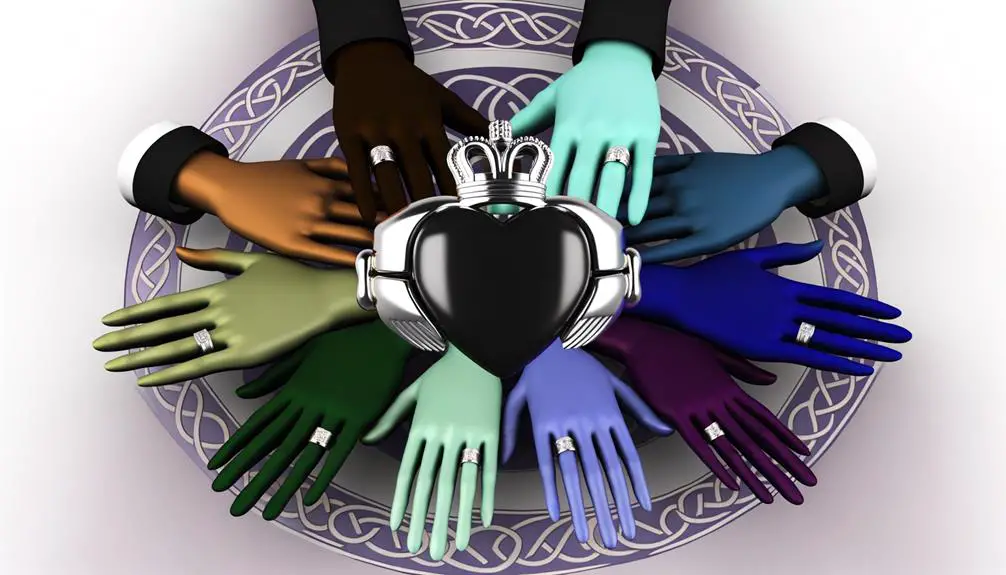
In contemporary times, the Claddagh symbol has evolved to embody a variety of modern interpretations, reflecting changes in cultural attitudes and personal expressions. Initially rooted in Irish heritage, its meanings have expanded beyond traditional boundaries. Today, the Claddagh is often viewed through the lens of individual experiences and societal shifts.
Diverse Relationships:
No longer confined to romantic contexts, the symbol now represents various types of relationships, including friendships and familial bonds.
Personal Empowerment:
The Claddagh is increasingly seen as a symbol of self-love and personal growth, aligning with contemporary values of self-empowerment.
Globalization:
As cultural symbols circulate globally, the Claddagh has been adopted by people of various backgrounds, signifying universal themes of love, loyalty, and unity.
This multifaceted evolution underscores the enduring relevance and adaptability of the Claddagh symbol in modern society.
Claddagh in Jewelry
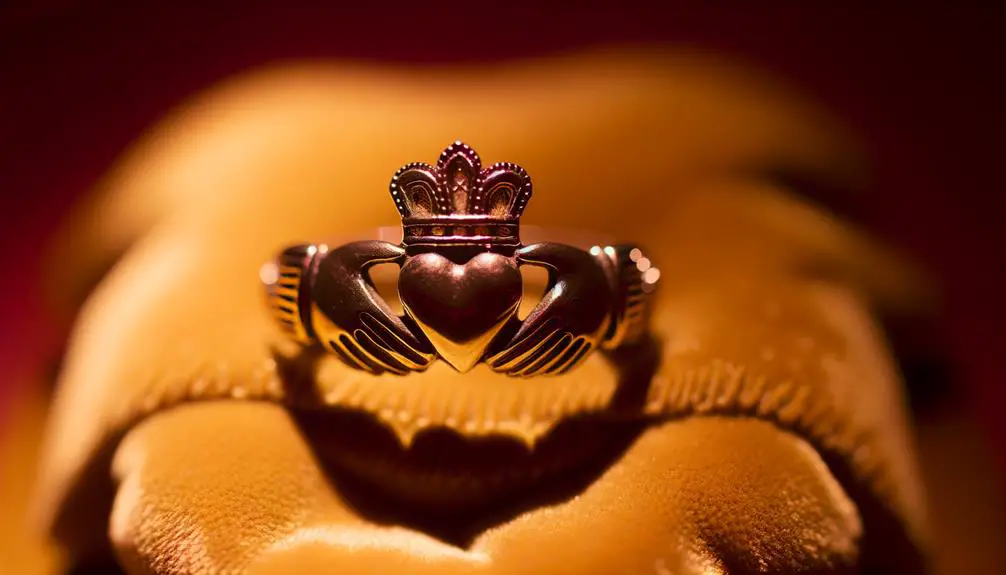
Worn as rings, necklaces, and bracelets, Claddagh jewelry has long served as a cherished emblem of Irish cultural identity and heritage. Originating in the 17th century in the fishing village of Claddagh, Galway, the design features two hands clasping a heart topped with a crown, symbolizing friendship, love, and loyalty.
Initially exchanged as wedding rings, Claddagh jewelry has evolved into versatile adornments, reflecting deep personal connections and ancestral pride. Beyond their aesthetic appeal, these pieces carry historical weight, often passed down through generations, preserving familial and cultural narratives.
The enduring popularity of Claddagh jewelry underscores its significant role in expressing and maintaining Irish traditions in a modern, globalized context.
Collecting Claddagh Pieces
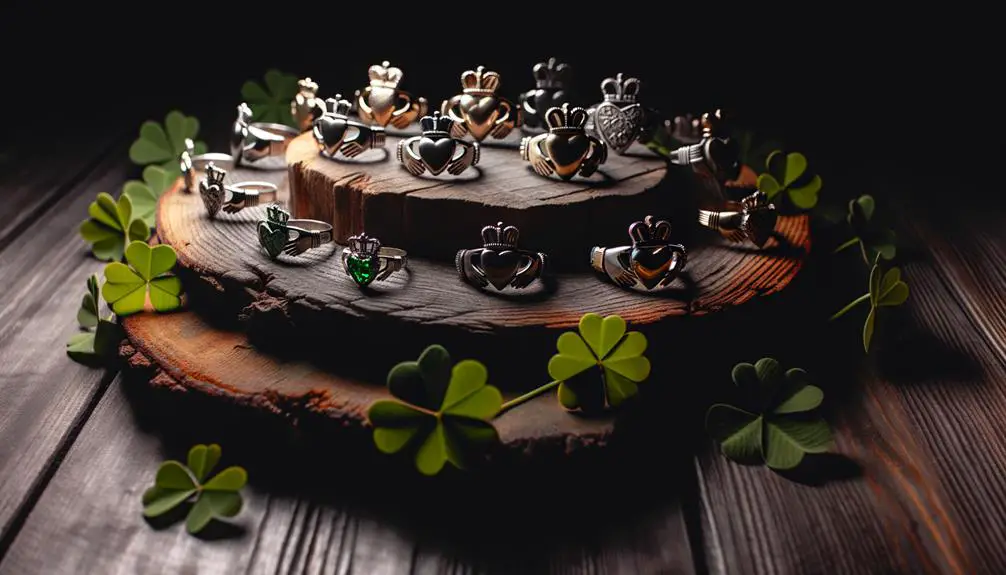
Collecting Claddagh pieces offers a captivating journey through Irish history and culture, revealing the intricate craftsmanship and deep symbolism embedded in each unique artifact. The Claddagh's design, featuring hands, a heart, and a crown, represents friendship, love, and loyalty. As collectors explore this domain, they uncover the following:
- Historical Evolution: From its 17th-century origin in the fishing village of Claddagh to modern adaptations, each piece tells a story of evolving artistic and cultural values.
- Craftsmanship: Examining different materials and techniques used, from traditional silver and goldsmithing to contemporary interpretations, highlights the skill of artisans.
- Cultural Significance: Each Claddagh piece is a wearable tribute to Irish heritage, often passed down through generations, encapsulating personal and communal histories.
Conclusion
The Claddagh symbol, steeped in rich history and profound cultural significance, encapsulates love, loyalty, and friendship through its intricate design.
As the heart, crown, and hands converge, they create a timeless emblem whose resonance spans centuries and transcends borders.
The precise moment when these elements unite evokes a sense of anticipation, leaving one to ponder the enduring legacy and evolving interpretations of this cherished motif.
The Claddagh continues to enchant, its mystery inviting deeper exploration.






